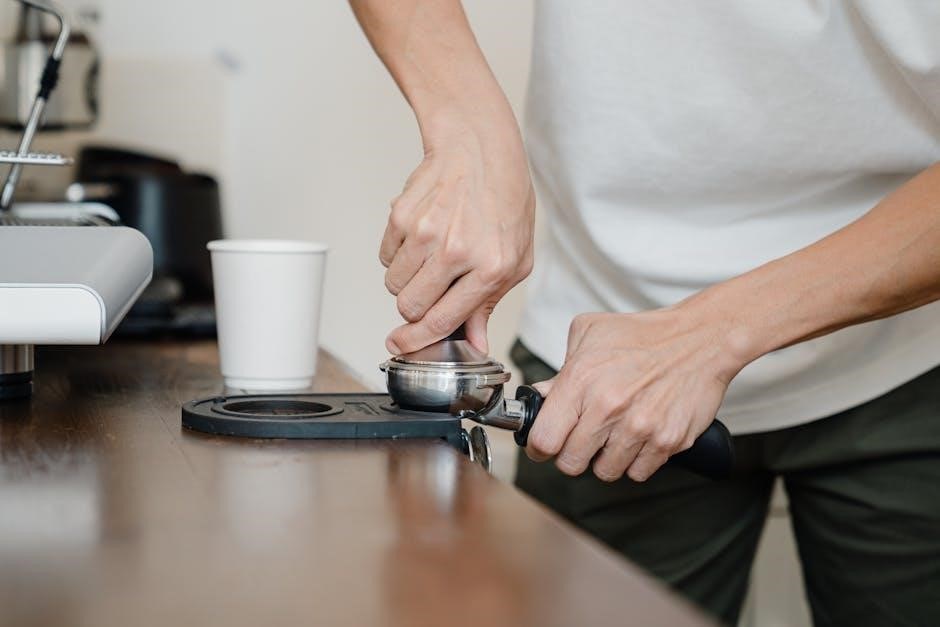Welcome to the world of food dehydration! Discover how to preserve fruits, vegetables, and meats using a food dehydrator. Learn about optimal drying times, temperatures, and techniques to ensure perfectly preserved foods every time.
What is a Food Dehydrator?
A food dehydrator is a kitchen appliance designed to remove moisture from food through controlled temperatures and air circulation. It helps preserve fruits, vegetables, meats, and herbs by evaporating water content, extending shelf life. Ideal for health-conscious eating, it retains nutrients and flavors while avoiding additives. Versatile for snacks, jerky, or herbs, it’s a practical tool for eco-friendly food preservation.
Benefits of Using a Food Dehydrator
A food dehydrator offers numerous benefits, including prolonged food preservation, nutrient retention, and reduced food waste. It allows for healthy snacks, homemade jerky, and flavorful herbs. Energy-efficient models ensure cost-effectiveness, while versatile settings support various food types. Preserving seasonal produce year-round is made easy, and the compact storage of dried foods saves space. Additionally, it’s a chemical-free method that maintains natural flavors and textures, making it ideal for health-conscious individuals and outdoor enthusiasts.
Importance of Drying Times in Food Preservation
Accurate drying times are crucial for food preservation, ensuring safety and quality. Under-drying can lead to spoilage and mold, while over-drying reduces flavor and texture. Proper drying prevents bacterial growth and retains nutrients. It also enhances storage stability, allowing foods to remain fresh longer. Adhering to recommended times ensures consistent results and maintains the food’s natural properties. This step is vital for both home use and long-term storage, making it a cornerstone of successful food dehydration.

Factors Affecting Drying Times
Drying times vary based on factors like air circulation, temperature, food thickness, and moisture content. Uniform airflow and consistent heat ensure efficient dehydration, while thicker slices take longer.
Temperature and Its Impact on Drying
Temperature plays a crucial role in food dehydration. Higher temperatures reduce drying time but risk overcooking or losing nutrients. Lower temperatures preserve flavors and nutrients but require longer durations. Most foods dehydrate efficiently between 50°C to 70°C, with precise settings depending on the food type. For example, herbs like basil thrive at lower temperatures to retain aroma, while meats require higher temperatures for safety. Always refer to a dehydration chart for specific guidelines to achieve optimal results without compromising quality or safety.
Thickness of Slices and Uniformity
Uniform slice thickness is essential for consistent drying. Thicker slices take longer to dry and may not dehydrate evenly, risking spoilage. Use a mandoline or sharp knife to achieve uniform cuts. Inconsistent thickness can lead to some pieces becoming too crispy while others remain moist. For optimal results, ensure all slices are of similar size and thickness before placing them in the dehydrator. This step is crucial for achieving evenly dried, high-quality results and preventing food waste;
Humidity and Air Circulation
Humidity and air circulation play a significant role in the drying process. High humidity slows evaporation, increasing drying time and risking mold growth. Ensure your dehydrator is used in a well-ventilated area to enhance air circulation. Proper airflow helps remove moisture efficiently, promoting even drying. If your dehydrator has adjustable fans, use higher settings for humid environments. Maintaining low humidity and optimal airflow ensures faster, safer, and more consistent dehydration, preserving the quality and shelf life of your foods.
Food Type and Water Content
The type of food and its water content significantly influence drying times. Fruits like strawberries, with high water content, dry faster than dense vegetables like carrots. Meats and fish, low in moisture, require precise temperatures to avoid over-drying. Herbs, such as basil, dry quickly due to their low water content, while thicker foods may need longer durations. Understanding the specific water content of each ingredient helps tailor dehydration settings for optimal results, ensuring foods are dry yet retain their flavor and nutrients. This knowledge is key to mastering dehydration across various food types.
Drying Times for Common Fruits
Discover the ideal drying times for popular fruits like apples, bananas, and mangoes. Learn how to achieve perfectly dehydrated fruits with our comprehensive guide and charts.
Apples: Slicing and Drying Guidelines
Apples are a popular choice for dehydration. Slice apples thinly, ideally between 3-5 mm, to ensure even drying. Dehydrate at 55°C for 6-8 hours. For chewier results, opt for 50°C for 8-10 hours. Properly dried apple slices should be flexible and free of moisture. Store them in airtight containers to maintain freshness. Always refer to your dehydrator’s guidelines for precise temperature and timing adjustments. This method preserves apples perfectly for snacks or recipes throughout the year.
Bananas: Optimal Thickness and Time
Bananas are best dried in slices or rings, 3-5 mm thick. Dehydrate at 55°C for 7-9 hours or until dry and flexible. Overripe bananas yield sweeter results. Peel and slice just before dehydration to prevent browning. For chewier texture, opt for 50°C for 9-11 hours. Ensure uniform thickness for consistent drying. Store dried bananas in airtight containers for up to 6 months. Adjust time based on moisture content and desired crispiness. Perfect for snacks or recipes, dried bananas retain their natural sweetness and nutritional value.
Mangoes: Drying Temperatures and Durations
Mango slices or wedges require precise temperatures and times for optimal drying. Dehydrate at 50°C for 6-8 hours or 55°C for 5-7 hours. Slice mangoes 5-6 mm thick, removing pits and skin. Uniform thickness ensures even drying. Overripe mangoes may need shorter times. Store dried mango in airtight containers for later use. Ideal for snacks or recipes, dried mango retains its vibrant flavor and nutrients. Adjust duration based on moisture and desired texture. Perfect for tropical recipes and healthy snacks, dried mango is a versatile and delicious option year-round.
Strawberries: Fast Drying Techniques
Strawberries dry quickly in a food dehydrator, typically requiring 5-7 hours at 50-55°C. For best results, slice or halve berries to ensure even drying. Uniform thickness is key to avoid under- or over-drying. Place strawberries in a single layer on trays, leaving space for air circulation. Check dryness by breaking a piece; it should snap cleanly. Store dried strawberries in airtight containers for up to 6 months. Perfect for snacking, baking, or adding to cereals, dried strawberries retain their sweet flavor and vibrant color. Optimal for preserving seasonal freshness year-round.

Drying Times for Common Vegetables
Discover optimal drying times for popular vegetables like carrots, spinach, tomatoes, and peppers. Blanching, slice thickness, and temperature significantly impact drying efficiency. Follow guidelines for crisp, flavorful results.
Carrots: Blanching and Drying Tips
Carrots require blanching before dehydration to preserve color and nutrients. Slice thinly, 1/8 inch thick, for even drying. Dehydrate at 135°F (57°C) for 6-10 hours until crisp. Store dried carrots in airtight containers for up to 6 months. Blanching ensures they retain their vibrant orange hue and prevents bitterness. Uniform slices guarantee consistent drying results. Lower humidity and proper air circulation speed up the process. Dried carrots are perfect for snacks, soups, or emergency food supplies. Always preheat your dehydrator and monitor progress for optimal texture.
Spinach: Leaves and Stems Preparation
Spinach leaves and stems can be dried separately for optimal results. Wash thoroughly, pat dry, and remove thick stems. Dehydrate leaves whole or chopped at 95°F (35°C) for 3-5 hours until brittle. Stems require blanching first; slice thinly and dry at the same temperature for 4-6 hours. Ensure uniform spreading on trays to prevent clumping. Monitor closely to avoid overdrying. Dried spinach retains its nutrients and adds flavor to dishes like soups and pasta. Proper preparation ensures a crispy texture and long shelf life for this versatile green.
Tomatoes: Slicing and Drying Methods
Tomatoes are a popular choice for dehydration, offering rich flavor in sauces and snacks. Slice tomatoes uniformly, 1/4 inch thick, to ensure even drying. Dehydrate at 135-145°F (57-63°C) for 6-12 hours. Blending into a puree or halving cherry tomatoes can reduce drying time to 4-6 hours. For chewier results, opt for lower temperatures (125°F/52°C) over 8-10 hours. Always pat dry before dehydration to remove excess moisture. Properly dried tomatoes are flexible and store well for future use, retaining their vibrant color and taste.
Peppers: Sweet and Hot Varieties
Peppers, both sweet and hot, are versatile for dehydration. Slice sweet peppers into 1/4-inch strips or rings, drying at 135°F (57°C) for 6-8 hours. For whole peppers, 8-10 hours is ideal. Hot varieties like jalapeños can be halved or left whole, drying at 125°F (52°C) for 6-8 hours. Uniform slicing ensures even dehydration. Store dried peppers in airtight containers for later use in soups or snacks. Always wear gloves when handling hot peppers to avoid skin irritation. Properly dried peppers are crisp and retain their vibrant color and flavor.

Drying Times for Meats and Fish
Meats and fish require precise drying times to ensure safety and quality. Beef jerky typically dries in 3-4 hours at 160°F (71°C), while fish like salmon takes 4-6 hours at 145°F (63°C). Proper preparation, including slicing thickness and fat removal, is crucial. Always store dried meats and fish in airtight containers to maintain freshness and prevent spoilage. Follow guidelines to ensure food safety and optimal results when dehydrating meats and fish.
Beef: Jerky Preparation and Drying
Beef jerky is a popular dehydrated snack that requires precise preparation and drying. Slice beef thinly into 1/4-inch strips, ensuring uniform thickness for even drying. Marinate the slices in your favorite seasonings for added flavor. Dehydrate at 160°F (71°C) for 3-4 hours, or until the jerky reaches your desired dryness. Properly dried jerky should bend but not break. Avoid over-drying, as it can become too crispy. Store the jerky in airtight containers to maintain freshness. Always follow safety guidelines to prevent spoilage and ensure a delicious, long-lasting snack.
Chicken: Safe Drying Practices
Drying chicken requires careful attention to temperature and preparation to ensure safety. Slice chicken into thin, uniform strips and pat dry to remove excess moisture. Dehydrate at 160°F (71°C) for 3-4 hours, or until fully dry and slightly flexible. Avoid under-drying, as this can lead to spoilage. Use a food-safe marinade if desired, but ensure it doesn’t interfere with drying. Store dried chicken in airtight containers to maintain freshness. Always follow food safety guidelines to prevent bacterial growth and ensure a safe, nutritious snack.
Salmon: Drying for Long-Term Storage
Drying salmon is an excellent way to preserve its rich flavor and nutrients. Slice salmon thinly, removing any bloodlines to prevent bitterness. Dehydrate at 140°F (60°C) for 6-8 hours, ensuring it reaches a jerky-like texture. Pat dry excess moisture beforehand for even drying. For long-term storage, vacuum-seal dried salmon and store in a cool, dark place. Proper dehydration prevents spoilage and retains omega-rich benefits. Follow safe practices to ensure a delicious, shelf-stable product perfect for snacking or cooking.

Drying Times for Herbs and Aromatics
Herbs like basil and rosemary dry best at low temperatures (90-100°F) for 6-12 hours. This preserves flavor and color. Store dried herbs in airtight containers.
Basil: Fresh vs. Dried Comparison
Fresh basil offers vibrant flavor and aroma, but its short shelf life makes drying a practical solution. Dried basil retains its essence and nutrients when dehydrated at 90-100°F for 6-12 hours. It’s ideal for year-round use in cooking. Fresh basil is perfect for garnishes and pesto, while dried basil is great for soups and sauces. Proper storage in airtight containers preserves its flavor. Drying basil at home ensures freshness and convenience, making it a versatile herb for any kitchen.

Rosemary: Low-Temperature Drying
Rosemary’s piney flavor is best preserved through low-temperature drying, typically at 95-100°F for 4-6 hours. This method prevents loss of volatile oils, ensuring aromatic retention. Fresh rosemary has a short shelf life, but drying extends its usability. Use whole sprigs or chopped leaves; both dry effectively. Store dried rosemary in airtight containers to maintain potency. This technique is ideal for home dehydrators, offering a convenient way to enjoy rosemary year-round without compromising its natural flavor and medicinal properties.
Mint: Fast Drying Techniques
Mint dries quickly in a food dehydrator, typically requiring 4-6 hours at 95-100°F. Its high moisture content means it’s prone to mold if not dried properly. For best results, rinse and pat dry leaves before placing them in a single layer on trays. Ensure good air circulation to prevent clumping. Store dried mint in airtight containers to preserve its fresh flavor. This method is ideal for retaining mint’s aromatic oils and vibrant color, making it perfect for teas, cooking, or crafts. Fast drying helps maintain its potency and extends shelf life effectively.

Creating a Custom Drying Time Chart
Design a personalized drying schedule by recording food type, slice thickness, temperature, and time. Adjust based on moisture content and dehydrator model for consistent results.
How to Measure Food Thickness
Measuring food thickness ensures uniform drying and accurate dehydration times. Use a mandoline or sharp knife to slice foods evenly. For precise measurements, a meat thermometer or food caliper can be used. Typical thickness ranges include 3-5 mm for fruits like apples and bananas, and 5-7 mm for meats.
- Always measure slices before placing them on dehydrator trays.
- Uniform thickness prevents under- or over-drying.
- Record measurements for future reference in your custom chart.
This step is crucial for consistent results and food safety.
Tracking Drying Progress and Adjustments
Monitoring your food’s drying progress is essential for achieving perfect results. Start by checking food after the minimum recommended time, then every 30 minutes to 1 hour. Look for visual cues like color change, texture, and flexibility. Use tongs or spatulas to gently flip or rotate pieces for even drying. If needed, adjust temperature or time based on food’s condition. Proper air circulation is key to preventing moisture buildup.
- Ensure consistent checking to avoid over-drying.
- Flip foods halfway through for uniform results.
- Refer to your drying time chart for guidance.
This step ensures safety and quality in your dehydration process.
Documenting Results for Future Use
Keeping track of your dehydration sessions is crucial for refining techniques and ensuring consistency. Create a log to record food types, slice thickness, temperature, time, and final texture. Note any adjustments made during the process, such as flipping or temperature changes. This data helps identify patterns and optimize future sessions. Store dried foods in airtight containers and label them with dates and contents. Referencing past results allows you to replicate successful batches and avoid mistakes. Over time, your documentation will become an invaluable resource for perfecting dehydration. Consistency and precision are key to mastery.
Safety Tips for Food Dehydration
Ensure proper food handling to prevent spoilage and foodborne illness. Always sanitize surfaces and utensils before use. Store dried foods in airtight containers to maintain freshness and safety.
Preventing Food Spoilage
To prevent spoilage, ensure food is completely dry before storage. Check dehydration times and temperatures using a reliable chart. Store dried foods in airtight, moisture-proof containers. Keep them in a cool, dark place to maintain freshness. Regularly inspect stored foods for signs of mold or rancidity. Proper sanitation of equipment and utensils is crucial to avoid contamination. Always follow safe food handling practices to preserve quality and safety.
Ensuring Proper Sanitation
Sanitation is key to successful food dehydration. Always wash hands before handling food. Clean and sanitize the dehydrator, trays, and utensils using soap and warm water. Regularly disinfect all surfaces to prevent bacterial growth. Ensure all food is washed thoroughly before dehydration. Proper sanitation prevents contamination and spoilage, ensuring safe and healthy dried foods. Regular maintenance of the dehydrator is also essential for optimal performance and hygiene. Follow these steps to maintain a clean environment for food preservation. Proper sanitation ensures the quality and safety of your dehydrated foods.
Proper storage is essential to maintain the quality of dried foods. Store them in airtight containers to protect from moisture and pests. Use glass jars or food-grade plastic containers with tight lids. Keep containers in a cool, dark place to preserve flavor and nutrients. Label containers with the date for easy tracking. For long-term storage, consider vacuum-sealing or using desiccants to absorb any remaining moisture. Regularly check stored foods for signs of spoilage or pests. Proper storage ensures your dried foods remain fresh and nutritious for months. Always store in a clean, dry environment to maintain quality and safety. Explore hybrid drying methods, combining dehydration with other techniques for unique textures. Utilize dehydrator accessories for optimal results. Experiment with creative recipes to enhance flavor and versatility. Hybrid drying methods combine dehydration with other techniques, like smoking or freeze-drying, for enhanced results. This approach allows for unique texture retention and flavor preservation. For meats, a combination of smoking and dehydration creates tender jerky. For herbs, pairing air-drying with freeze-drying maintains vibrant colors and aromas. These methods often require precise temperature control and specialized equipment. While they offer superior outcomes, they can be more complex and time-consuming. Experimenting with hybrid techniques can elevate your food preservation game, offering diverse and exciting possibilities for home cooks and enthusiasts alike. Dehydrator accessories can significantly enhance your food preservation experience. Non-stick sheets are ideal for delicate foods like herbs or yogurt, preventing sticking and simplifying cleanup. Spice racks or herb trays allow for efficient drying of aromatic plants, while drip trays capture excess moisture from meats or fruits. Mesh screens promote airflow for even drying, especially for small items like berries; These accessories expand the versatility of your dehydrator, ensuring optimal results for various food types. By utilizing the right tools, you can achieve professional-grade dehydration outcomes with minimal effort and maximum efficiency. Expand your culinary creativity by experimenting with new recipes using your dehydrator. From savory meat jerky to vibrant fruit leather, the possibilities are endless. Try combining herbs like rosemary or thyme with vegetables for unique flavors. Blend spices into marinades for meats or create custom seasoning mixes. Dehydrate flowers for teas or infuse fruits into homemade powders. This versatile appliance encourages innovation, allowing you to craft healthy snacks, aromatic blends, and gourmet dishes. Experiment freely to discover new tastes and textures, making each dehydration session a delightful adventure. Address common dehydration challenges like uneven drying, over-crisping, or incomplete dehydration. Check for blockages, ensure even slicing, and monitor temperature settings for consistent results. Uneven drying can occur due to inconsistent slice thickness, overcrowded trays, or poor air circulation. Rotate trays midway through the cycle and ensure even food distribution. Check for blockages in air vents and maintain uniform slice sizes. If using thick slices, extend drying time slightly. For delicate foods, monitor progress to prevent under- or over-drying. Refer to your dehydrator’s guide for specific troubleshooting tips. Adjusting these factors ensures consistent results and prevents uneven drying. Proper preparation and monitoring are key to achieving perfectly dried foods every time. If your dehydrator isn’t heating, check the power connection and ensure it’s plugged in correctly. Verify the temperature setting matches your recipe. Clean or replace faulty heating elements and ensure proper air circulation around the unit. Check for blockages in vents or trays that might restrict airflow. If issues persist, consult the user manual or contact customer support; Regular maintenance and troubleshooting can resolve heating problems, ensuring optimal performance for your food dehydration needs. Always follow safety guidelines when addressing electrical components to avoid further issues or hazards. If your food becomes too crispy during dehydration, it may be due to over-drying. Check the drying time and temperature settings, as excessive heat or prolonged dehydration can cause this issue. Ensure slices are of uniform thickness to prevent uneven drying. Monitor the dehydration process closely, especially toward the end, and remove food once it reaches your desired texture. Lowering the temperature slightly can also help prevent over-drying. Proper air circulation and consistent tray loading are key to achieving the perfect dryness level without making food overly crispy. Advancements in food dehydration technology promise smarter, energy-efficient dehydrators with app connectivity for remote monitoring. New materials and designs enhance performance, offering precise temperature control and faster drying times. Smart dehydrators are revolutionizing food preservation with app connectivity, allowing users to monitor and control the dehydration process remotely. These advanced devices enable precise temperature adjustments, timer settings, and real-time notifications. Apps provide access to predefined drying charts for various foods, ensuring optimal results. Remote monitoring reduces the need for constant supervision, while smart algorithms adapt to food types and thickness for even drying. This integration of technology enhances convenience, efficiency, and consistency, making food dehydration more accessible and user-friendly than ever before. Energy-efficient dehydrators are designed to minimize power consumption while maintaining optimal drying performance. These models often feature advanced insulation, smart sensors, and adaptive heating systems to reduce energy use. Eco-friendly designs ensure lower operating costs and environmental impact. Many modern dehydrators include energy-saving modes that adjust power based on food type and moisture levels. This focus on efficiency aligns with the growing demand for sustainable kitchen appliances, making dehydration more accessible and environmentally responsible for home users. Modern food dehydrators now feature innovative materials and designs that enhance performance and user experience. Stainless steel trays and BPA-free plastics ensure durability and safety. Non-stick coatings simplify food removal, while transparent panels allow monitoring without interruption. Sleek, compact designs save kitchen space, and digital touchscreens offer precise control. Some models incorporate modular components for versatility, catering to diverse drying needs. These advancements not only improve efficiency but also make dehydration more accessible and enjoyable for home users, ensuring high-quality results with minimal effort.Storing Dried Foods Correctly

Advanced Drying Techniques
Hybrid Drying Methods
Using Dehydrator Accessories
Experimenting with New Recipes
Troubleshooting Common Issues
Food Not Drying Evenly
Dehydrator Not Heating Properly
Food Becoming Too Crispy

Future of Food Dehydration Technology

Smart Dehydrators and App Connectivity
Energy-Efficient Models
New Materials and Designs

